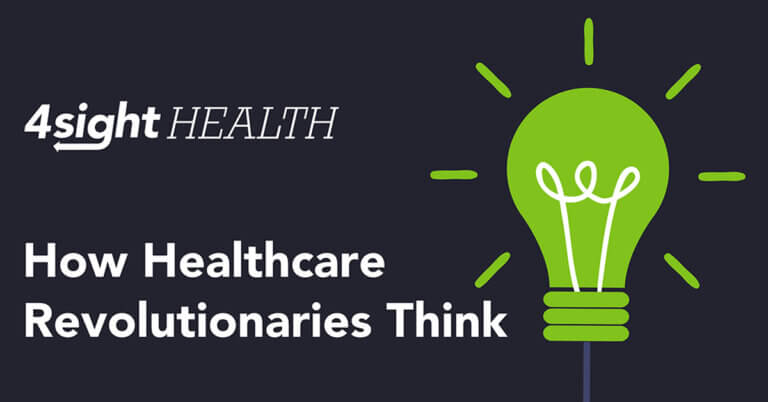April 25, 2023

The R.N. and the Controller: Two Revolutionaries Battle the Healthcare Industrial Complex®
The 1970s was a dark period in U.S. history. Watergate, the energy crisis, environmental degradation, stagflation, rising crime, high unemployment and plunging consumer confidence led many to believe that America’s best days were behind us. I remember it as a time when it was almost impossible to get a job at McDonald’s. The decade ended with Jimmy Carter’s infamous “malaise” speech where he decried the nation’s crisis of confidence.
The movie “Network” from 1976 captured the nation’s anxiety, frustration and cynicism. Peter Finch plays respected TV anchorman Howard Beale who has had enough. In an iconic scene, Beale, drenching wet in a khaki trench coat, ends a caustic rant by imploring his nationwide audience to get out of their chairs, open their windows and scream, “I’m as mad as hell and I’m not going to take this anymore.” They follow him in droves.
I’m often mad as hell at the U.S. healthcare system. Its inequities, profligacy, profiteering and callousness create untold physical, emotional, psychological and financial harm. It’s so bad that a 2018 survey by West Health and NORC found that more Americans fear paying the medical bills for a costly illness than contracting the illness itself.
4sight Health believes a customer-led revolution can transform U.S. healthcare. Better buyers, liberated data and pro-market regulation are the force multipliers that can combine and topple the massive Healthcare Industrial Complex®.
As part of our quest, 4sight Health celebrates revolutionaries who wake up every morning intent on reforming our broken healthcare system. Operating on healthcare’s frontlines, they tirelessly pursue system transformation. Their goals are our goals: the right care at the right time, in the right place and at the right price for everyone.
Their mantra is our mantra: Outcomes matter; customers count and value rules. Importantly, our healthcare revolutionaries have the courage of their convictions. They’re acting for the common good. They’re making progress one patient encounter, one transaction, one outcome at a time. They’re building momentum. They’re role models for a kinder, smarter, affordable and inclusive healthcare delivery. They create hope amid misery.
I’ve had recent encounters with two impressive healthcare revolutionaries. Their success in challenging status-quo business practices make me believe that system transformation is possible. We aren’t just tilting at windmills.
Rebeckah Orton is a Harvard researcher turned doula turned registered nurse (RN) who has the audacity to believe that freestanding birth centers can reverse America’s dismal maternity statistics. Mark Pinsley is the elected Controller of Lehigh County, Pennsylvania. Pinsley has the audacity to use publicly available price data to become a better buyer of healthcare services.
These are their stories.
Rebeckah from Astoria Birth Center
 As a college student at Brigham Young University — Idaho (BYUI), Rebeckah Orton pursued a degree in microbiology with the goal of attending medical school and becoming a specialist physician in high-risk obstetrics. As she neared graduation, she had a change of heart. She did an internship with nurse midwives at a local hospital and loved it.
As a college student at Brigham Young University — Idaho (BYUI), Rebeckah Orton pursued a degree in microbiology with the goal of attending medical school and becoming a specialist physician in high-risk obstetrics. As she neared graduation, she had a change of heart. She did an internship with nurse midwives at a local hospital and loved it.
That internship planted a seed that took some time to sprout. Rather than attend medical school, Orton used her biology training to manage an oncology lab and subsequently participated in malaria research at the Harvard School of Public Health.
These professional experiences gave Orton a first-hand look at the waste and inefficiency embedded within the American healthcare system. She was particularly appalled by the entrenched and counter-productive practices governing maternal and child care.
Before continuing with her story, let’s detour slightly to discuss the costs and outcomes of conventional childbirth in the United States. Here’s a passage from the introduction of my last book, “The Customer Revolution in Healthcare,” that caught Orton’s attention. It’s easy to see why.
The average birth in the United States cost 21% more than the latest royal birth in Great Britain. Prince William and Princess Kate welcomed 8-pound, 7-ounce Louis to this world on April 23, 2018, in the posh Lindo Wing at St. Mary’s Hospital in London. The cost for a non-Cesarean birth at Lindo in 2015 was $8,900. An equivalent birth in the U.S. that year cost $10,808. Does that turn every American-born baby into a prince or princess? [1]
The answer to my rhetorical question is, of course, no. Medicaid now funds more than 40% of births in the United States. At the same time, 99% of privately insured births occur in hospitals. Doctors oversee over 90% of these births.
Medicaid reimbursement payments covering these births vary by state, but are substantially lower than those paid by commercial health insurance plans. Prenatal and postnatal care is inconsistent. This explains, in part, why infant and maternal mortality statistics in the U.S. are far higher than in other advanced economies.
Shockingly, more American mothers die in childbirth today than a generation ago. The US is also only one of three nations in the world with increasing maternal mortality rates. The other two are in sub-Saharan Africa.
The dismal U.S. performance in maternal and child care got Orton’s blood boiling, so she decided to do something about it. In Seattle she became a doula, a professional who provides expert guidance and support to pregnant women during childbirth. When Oregon became the first state in the country to reimburse for doula services, she moved with her family back to her hometown of Astoria, Oregon and began practicing there.
Here’s the rub: Oregon’s Medicaid program initially paid doulas only $75 for roughly 40 hours of work including two prenatal visits, two post-natal visits and the delivery. It increased this payment to $350 in 2017. Orton became a certified midwife and a registered nurse. She opened the Astoria Birth Center and Family Medicine in 2020, earned an RN degree in 2022. Along the way she became a full-throated advocate for community birth and midwives.
The statistics supporting birth centers are jaw-dropping. Cesarian sections occur in roughly a third of hospital births. Only 6% of pregnant women require Cesarian delivery in birth centers. Women giving birth in hospitals receive epidural anesthesia in over 60% of cases. In birth centers it’s under 10%.
In a risk-matched comparison of low-risk vaginal births, birth centers achieve a substantially lower maternal mortality rate (0.7 compared to 32.9 per 100,000 live births) than the U.S. overall. Maternal mortality at birth centers compares favorably to the low mortality rates achieved by the top-10 best-performing countries. Birth centers achieve these low maternal mortality rates despite serving a disproportionate number of low-income patients.
Potential savings for initiating the birthing experience at birth centers are enormous. Even after paying birth centers the same Medicaid facility fee as hospitals, Orton estimates that the state of Oregon could save $94 million annually from lower C-section rates alone. Fewer epidurals, fewer neonatal admissions and fewer ancillary hospital services would increase savings even further.
Better outcomes at lower costs with great customer service is value-based care in action. Demand for birth centers is growing. A logical question follows. Why doesn’t the healthcare system encourage more birth center deliveries? That’s the question Orton put to leaders of Oregon’s 12 health insurance companies on April 19 in a session arranged by the state’s insurance commissioner. We await their response.
You can read more about healthcare revolutionary Rebeckah Orton in Dave Burda’s 10 Questions with Healthcare Revolutionaries interview. You can also hear about her family’s experiences as Medicaid enrollees — and why we clearly need to pay birth centers more — in the companion 4sight Health podcast.
Mr. Pinsley Goes to Allentown
 For almost years, Mark Pinsley has been a successful innovator, entrepreneur and marketing executive at companies large and small. In 2011, Pinsley and his partner Ginger Hodulik acquired DermaMed Solutions, a skincare company that works with spa owners, dermatologists and other medical professionals to expand their practices and service offerings.
For almost years, Mark Pinsley has been a successful innovator, entrepreneur and marketing executive at companies large and small. In 2011, Pinsley and his partner Ginger Hodulik acquired DermaMed Solutions, a skincare company that works with spa owners, dermatologists and other medical professionals to expand their practices and service offerings.
Under Hodulik and Pinsley’s leadership, DermaMed has transformed into a company that combines mechanical treatments, topical skincare and nutrition-based wellness protocols to improve long-term skin health. Business was and continues to be good, but the election of Donald Trump as U.S. president in 2016 pushed Pinsley into politics. He wanted to prove that government was more than a swamp, and that it could make a positive difference in people’s lives.
After working in local township governance, the voters of Lehigh County Pennsylvania elected Pinsley as their County Controller — aka the county’s fiscal watchdog. He ensures that the county government spends and manages taxpayer money effectively and in accordance with the law.
Lehigh County is located in the southeast corner of Pennsylvania, 61 miles northwest of Philadelphia and 99 miles west of New York City. The county has 375,000 people. Demographically, it is 61% white, 26% Hispanic, 6% black and 4% Asian. Its county seat is Allentown, Pennsylvania’s third largest city after Philadelphia and Pittsburgh.
Lehigh County is among Pennsylvania’s fastest-growing areas and home to two large health systems: St. Luke’s University Health Network (St. Luke’s) and Lehigh Valley Health Network (Lehigh Valley). The county self-insures for the healthcare coverage of 2,400 employees, family members and retirees.
 As controller, Pinsley also looks for ways that the county can save money. The county’s annual health insurance coverage expenditures for its employees eats up approximately $30 million of its $500 million budget. As a self-insured employer for healthcare coverage, Pinsley thought becoming a better buyer of healthcare services could generate savings for the county. Boy, did he hit paydirt.
As controller, Pinsley also looks for ways that the county can save money. The county’s annual health insurance coverage expenditures for its employees eats up approximately $30 million of its $500 million budget. As a self-insured employer for healthcare coverage, Pinsley thought becoming a better buyer of healthcare services could generate savings for the county. Boy, did he hit paydirt.
Pinsley’s first target was the county’s pharmaceutical spend, which added up to $7.5 million. He compared the county’s costs for specific drugs against the pricelist from GoodRx and found a significant gap.
Pinsley realized the county wasn’t getting the full amount of manufacturer rebates from Express Scripts (ESI), its Pharmacy Benefit Manager (PBM). Like many PBM’s, ESI was charging its insurers more for the drugs it was dispensing than it was paying its pharmacies for acquiring the drugs. This practice is called “spread pricing.” It’s great for PBMs but terrible for self-insured employers.
Through negotiation and by rebidding the pharmacy contract, the County reduced its annual drug spending by 40%. This amounted to $3 million in savings. CapitalRx became the county’s new PBM. Next, Pinsley set his sights on the County’s spending for hospital and physician services. He found gold in them thar hills, too.
On Jan. 1, 2021, new nationwide pricing transparency rules for hospitals went into effect. The new rules required hospitals to post their negotiated treatment prices with all commercial insurers, their discounted cash prices, and standard charges for all items and services in a machine-readable, easy-to-access format. Pinsley became an expert at reading and understanding these price lists.
Like many hospitals in the country, Lehigh Valley failed to comply with the new rules and paid fines for noncompliance. St. Luke’s, on the other hand, has complied with the rules. Pinsley conducted an audit of the county’s healthcare expenditures, comparing hospital cash prices to the county’s contracted payment rates for identical services. Using this type of reference-based pricing, he believes the total savings potential could be close to $4 million.
Pinsley expects to lower the county’s overall healthcare expenditures by close to 25% over the next three years. He believes savings of this magnitude are open to any employer that self-insures for their healthcare expenditures.
With this in mind, Pinsley planned to publicize the county’s efforts to identify and eliminate waste in their healthcare purchasing. Before doing so, he received a call from the county’s health insurer, its health insurance broker and the county solicitor. They threatened to sue the Controller’s Office and Pinsley personally if he made his findings public. They felt Pinsley was violating the non-disclosure and confidentiality terms embedded in the County’s insurance contract.
This fear-mongering behavior isn’t surprising. Entrenched interests often use intimidation to ward off potential threats to their parochial interests. Pinsley hired an outside counsel to help guide his decision-making. After a sobering conversation with his wife, they decided Pinsley owed it to the citizens of Lehigh County to risk the lawsuits and publish his findings.
On October 25, 2022, Pinsley’s office issued a press release with the provocative title, “Lehigh County Controller Exposes Insurance Industry Failures and Price Gouging, Costing Consumers Millions.” The threatened lawsuits never materialized.
The press release’s final paragraph quotes Pinsley and exemplifies his revolutionary fervor. Let’s give him the final word:
“This audit speaks to a healthcare system that is fundamentally broken, wasteful, shrouded in mystery, resistant to transparency and beholden to profits. This report should spur to action consumer advocates, healthcare champions and elected officials across the country,” said Controller Pinsley.
Conclusion: Support the Revolution & Revolutionaries
 In the counterculture movement that flourished into the 1970s, “The Man” was a derogatory term used to represent institutional authority. Reciprocal phrases play on this concept. “The Man is keeping me down” implies oppression. “Sticking it to The Man” implies support for civil disobedience.
In the counterculture movement that flourished into the 1970s, “The Man” was a derogatory term used to represent institutional authority. Reciprocal phrases play on this concept. “The Man is keeping me down” implies oppression. “Sticking it to The Man” implies support for civil disobedience.
In his own way, fictional newscaster Howard Beale was encouraging his followers to go out into the streets and take on “The Man.” With the same energetic spirit, it’s time to take on “The Man” in healthcare. The best way to do this is by forcing entrenched incumbents to confront their own value-destroying behaviors in public forums.
Healthcare is transforming from the bottom-up through the collective efforts of healthcare revolutionaries like Rebeckah Orton and Mark Pinsley. Orton, Pinsley and others like them are addressing healthcare’s dysfunction in their own communities on their own terms. These healthcare revolutionaries need our help. Let’s all jump the barricades with them.
If America can fix its broken healthcare system, it will free up enormous resources to pay higher wages, support productive industries and make vital societal investments. If we fail to fix healthcare, we’re destined to spend ever more money to care for our people even as they become sicker, more isolated and less productive.
We have the means to fix American healthcare. The real question is whether we have the will. To quote Rabbi Hillel the Elder, a Jewish leader, sage and scholar from over 2,000 years ago, “If not now, then when? If not by us, then by whom?”
Sources





